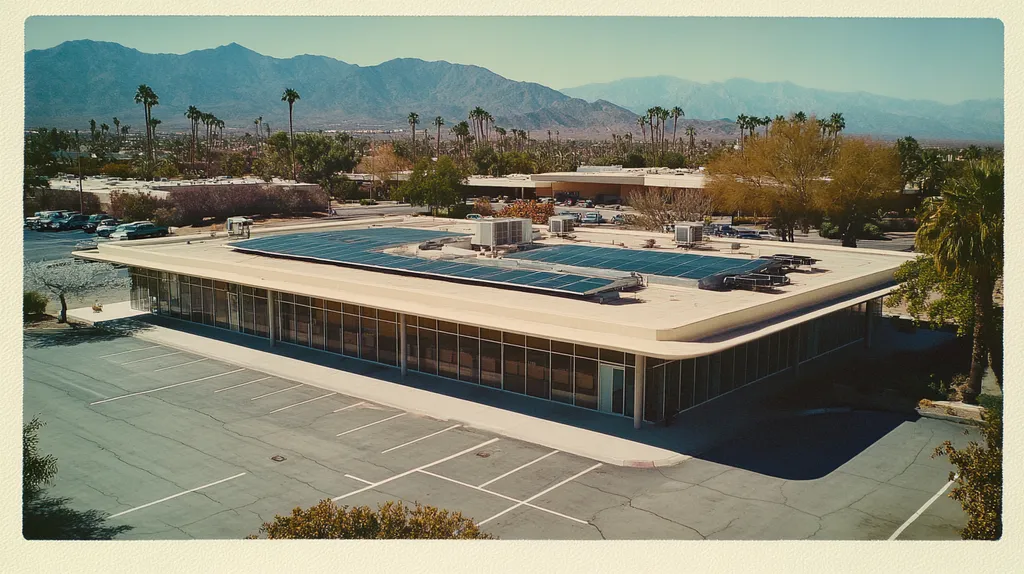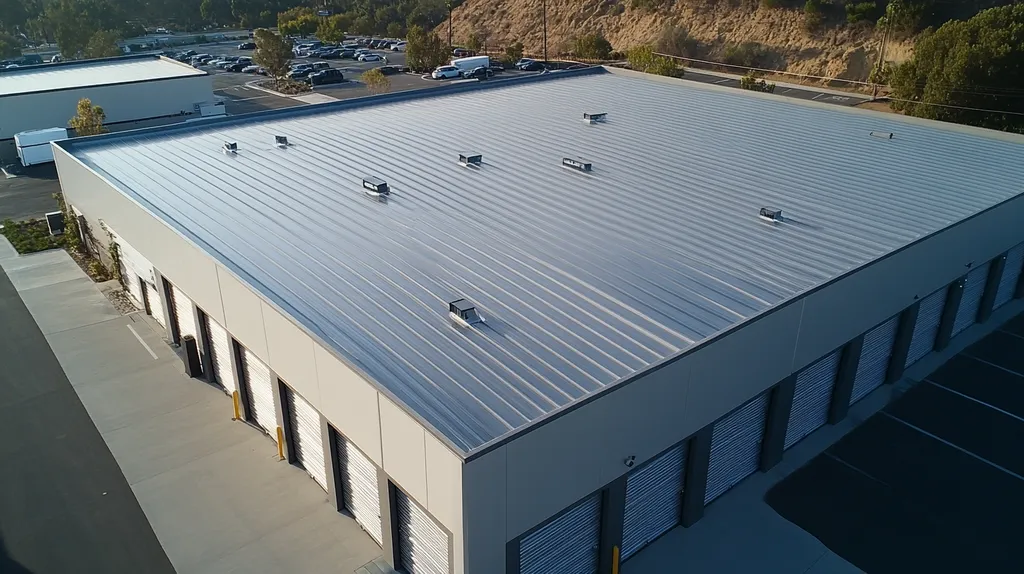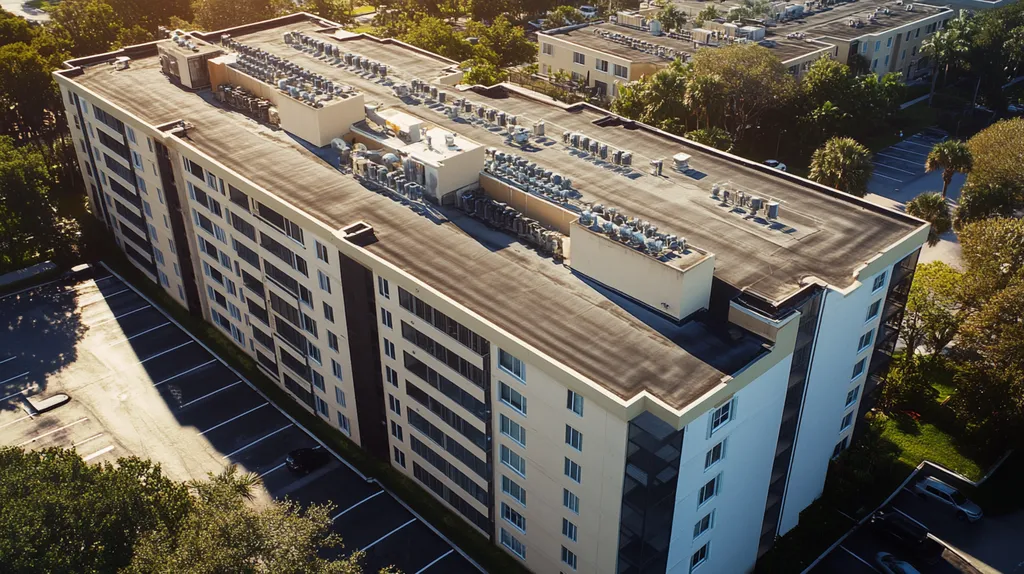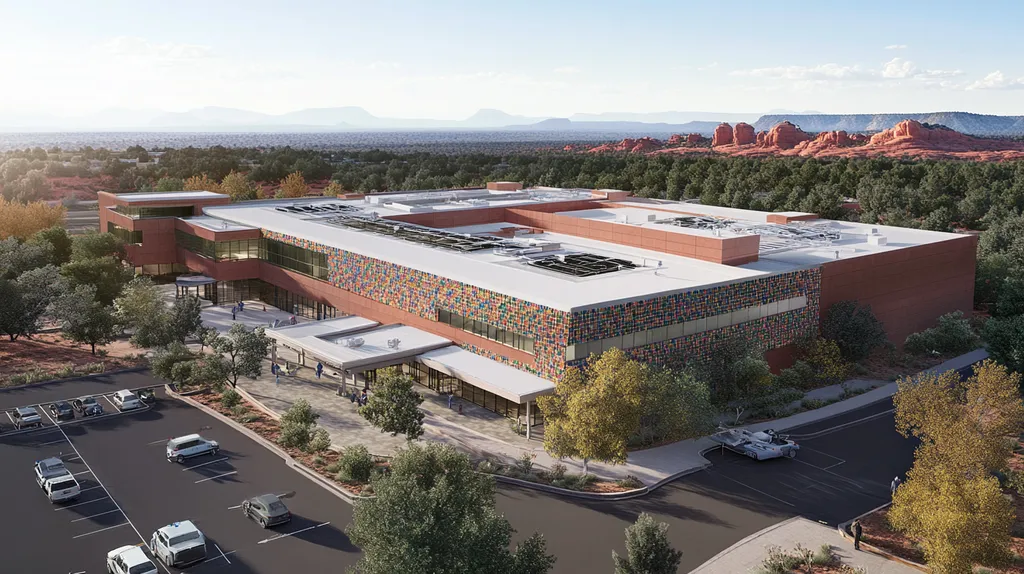Commercial property owners face a critical challenge: buildings waste up to 30% of their energy through inefficient roofing systems, leading to thousands in unnecessary costs annually.
While traditional roofing materials absorb and transfer heat into facilities, modern coating solutions can reflect up to 85% of solar radiation and reduce cooling expenses by 20-30%.
This comprehensive guide examines key factors in selecting and implementing energy-efficient roof coatings, from performance metrics and financial considerations to compliance requirements and long-term maintenance strategies.
SECTION 1: PERFORMANCE FACTORS
Energy efficiency in commercial roofing is a pressing concern for property owners and facility managers. With nearly 30% of energy consumed in commercial buildings allocated for heating and cooling, the choices made in roofing materials can have a significant impact on both costs and the environment. This section explores critical factors such as heat reflection and absorption, roof surface temperature reduction, and HVAC load optimization, offering clear steps to improve roof energy efficiency.
Heat Reflection and Absorption
Heat reflection is vital for enhancing the performance of commercial roofs. Materials with high solar reflectance, such as white or light-colored roofing systems, can reflect up to 85% of solar radiation, minimizing heat absorption. This reflective capacity significantly lowers the surface temperature of the roof, leading to a reduced cooling load on HVAC systems.
In hot climates, opting for reflective roofing can lead to energy cost reductions of 20-30% when compared to darker surfaces. Notably, not all reflective products are equal—property managers should prioritize coatings rated by the Cool Roof Rating Council to ensure top performance standards.
The material’s emissivity, indicating its ability to release absorbed heat, also affects energy efficiency. Roofs with low emissivity tend to retain more heat, increasing cooling demands. Selecting a reflective roofing solution can yield substantial financial savings while prolonging the lifespan of the roofing system.
Key Action Items
Roof Surface Temperature Reduction
Lowering roof surface temperatures is crucial for energy efficiency. Elevated surface temperatures not only increase cooling loads but also accelerate the deterioration of roofing materials. Cool roofing coatings can achieve temperature decreases of 50°F or more, resulting in less thermal expansion and contraction, which extends the lifespan of the roofing system.
Moreover, research indicates that reducing roof temperatures can mitigate urban heat island effects, consequently improving air quality and comfort in surrounding environments. The adoption of energy-efficient coatings can lead to noticeable savings in maintenance costs over time, as cooler roofs are less susceptible to issues like cracking and blistering.
In essence, actively lowering roof surface temperatures directly correlates with cost savings and aligns with sustainability initiatives.
Key Action Items
HVAC Load Optimization
Optimizing HVAC loads is essential for achieving energy efficiency in commercial buildings. A roof that is both well-insulated and reflective minimizes heat penetration, allowing HVAC systems to operate more effectively. This optimization can lead to substantial energy savings, as lowering indoor temperatures by just one degree Fahrenheit can have a significant impact on energy demand.
Research has shown that better roof performance can also facilitate the downsizing of HVAC equipment, resulting in lower initial costs and reduced maintenance expenses. Regular assessments are key for facility managers to ensure roofing systems are functioning at peak efficiency.
In summary, a proactive approach to roof energy efficiency reduces operational costs and significantly enhances occupant comfort within the building.
Key Action Items
SECTION 2: FINANCIAL CONSIDERATIONS
Evaluating the financial implications of roof coatings is essential for property professionals committed to enhancing energy efficiency. Investing in these coatings can significantly influence a facility’s operational costs and its sustainability objectives. Reflective roof coatings have the potential to cut cooling costs by as much as 30%, according to research from the U.S. Department of Energy. This section will examine the upfront costs, long-term savings, and maintenance considerations linked with using roof coatings.
Upfront Costs and Installation Expenses
When contemplating roof coatings, property professionals often encounter upfront costs that may appear intimidating. The investment for high-quality coatings often ranges from $1 to $3 per square foot, depending on the type and application method. It’s crucial to view these costs not merely as expenses but as strategic investments in the future.
Installation may also bring additional expenses, particularly if the existing roof needs repairs or preparatory work. Engaging experienced contractors can increase initial costs, but this investment often pays off by ensuring quality workmanship and strong warranties, ultimately protecting against future financial setbacks due to poor installation.
Effective budget planning for these upfront investments is imperative. Facility managers should assess not just the initial costs but also weigh in the long-term benefits, promoting energy-efficient roofs as essential to the financial wellness of a property.
Key Action Items
Long-Term Energy Savings and ROI
The energy savings achieved through roof coatings create a solid argument for investment. By reflecting solar energy, these coatings substantially reduce cooling requirements during peak temperatures, leading to notable decreases in monthly utility bills.
Property owners can realize a return on investment (ROI) that ranges from 50% to over 100%, influenced by factors such as facility size and regional climate. Tracking energy consumption before and after coating application allows facility managers to validate these savings directly. As energy prices rise, these financial benefits become increasingly critical.
Furthermore, taking advantage of utility company programs and incentives enhances the ROI. Many utilities provide rebates and financing options for energy-efficient upgrades, making coated roofs an even more appealing investment.
Key Action Items
Maintenance and Repair Cost Reduction
One often overlooked advantage of roof coatings is their capacity to lessen long-term maintenance and repair expenses. These coatings create a protective shield against damaging solar UV rays, moisture, and extreme temperature changes, significantly extending the roof’s lifespan and delaying costly replacements.
Facilities with reflective coatings frequently report fewer leaks and diminished deterioration, crucial in industrial environments where roof failures can lead to significant disruptions and repair costs.
Additionally, a well-maintained coated roof lowers the need for constant repairs, allowing facility managers to focus resources elsewhere. Routine inspections can help identify and address minor concerns before they escalate, promoting sustained savings.
Key Action Items
SECTION 3: COMPLIANCE REQUIREMENTS
Compliance with energy efficiency standards is more than just a legal necessity; it holds considerable financial weight as well. Property owners can enjoy savings of up to 30% on energy costs by adhering to established guidelines. Furthermore, obtaining certifications like ENERGY STAR and LEED can elevate a property’s appeal in the market. Understanding these compliance requirements is essential to maximize energy efficiency and sustainability.
ENERGY STAR and LEED Certification
ENERGY STAR and LEED serve as vital benchmarks for measuring energy efficiency in commercial properties. The ENERGY STAR program includes a rating system that assesses energy performance, providing a credible certification that demonstrates a property’s commitment to sustainable practices.
LEED, or Leadership in Energy and Environmental Design, evaluates a wider range of environmental impacts. Properties awarded LEED certification are often more attractive to tenants who value sustainability.
To achieve these certifications, property owners must invest in energy-efficient roof coatings that contribute to their properties’ ratings. Though the initial costs may be apparent, the long-term energy savings and improved property value make such an investment worthwhile.
Key Action Items
Local Building Codes and Regulations
Local building codes provide crucial guidelines to ensure that roofing systems meet minimum energy efficiency requirements. These codes vary significantly depending on geographic location and climate, making awareness necessary for compliance.
Many municipalities require the use of reflective roofing materials that align with energy efficiency standards. Energy-efficient coatings play a vital role in meeting these regulations while enhancing overall performance.
Staying informed about local codes can help prevent costly infractions and renovations down the line. Regular communication with local building departments is key to adapting to any changes in regulations.
Key Action Items
Environmental Sustainability Standards
As sustainability continues to rise in importance, adhering to environmental standards becomes vital for businesses. These standards often incorporate requirements for energy efficiency, waste reduction, and overall impact on the environment.
Implementing energy-efficient roofing coatings aligns with these guidelines, enhancing a property’s sustainability profile by reducing heat absorption and reliance on cooling systems.
Properties committed to sustainability often benefit from lower operating costs and higher tenant satisfaction. As eco-consciousness grows among tenants, compliance opens doors to potential tax incentives and rebates that can strengthen financial returns.
Key Action Items
SECTION 4: RISK MANAGEMENT
As extreme weather patterns become the norm, commercial roofs must be fortified against unprecedented risks. Climate change brings more severe storms and heatwaves, making it crucial for property owners to adopt effective risk management strategies. Issues related to extreme weather, water intrusion, and thermal expansion threaten the integrity of roofing systems, potentially leading to costly repairs and energy inefficiencies. This section delves into these risks and outlines actionable solutions to protect the roof’s performance.
Protection Against Extreme Weather
Extreme weather events, including hurricanes and heavy snow, can severely damage commercial roofs. Utilizing durable roofing coatings enhances a roof’s ability to withstand these harsh conditions. For example, reflective coatings help keep roof temperatures lower during extreme heat, preventing the softening and degradation of roofing materials.
Furthermore, elastomeric coatings offer increased flexibility, allowing roofs to expand and contract without sustaining damage. This flexibility is crucial for preventing cracks during sudden temperature shifts. Without these protective coatings, roofs are susceptible to wind uplift and structural failures, leading to significant repair costs.
Investing in appropriate coatings not only fortifies roofs against extreme weather but also sustains their longevity and operational capacity. Recognizing this necessity can mean the difference between minor repairs and complete roof replacements, ultimately impacting business continuity.
Key Action Items
Prevention of Water Damage and Leaks
Water intrusion is a critical concern for commercial roofs, often resulting in extensive damage if not effectively managed. Aging roofs are particularly vulnerable to leaks due to cracks and seam failures that allow moisture to penetrate. Implementing high-quality coatings can seal these vulnerabilities and provide comprehensive protection against leaks.
Advanced waterproof coatings help minimize pooling water and enhance drainage, thereby reducing long-term water damage risks. Conducting regular inspections, alongside timely coating applications, allows for the early detection of potential issues. This proactive strategy helps property owners avoid costly repairs and ensures sustained energy efficiency.
Investing in solutions to prevent leaks not only protects the value of the asset but significantly improves overall energy performance. Property managers should prioritize high-performance coatings tailored to their specific roofing systems as a preventive measure.
Key Action Items
Mitigation of Thermal Expansion Damage
Thermal expansion and contraction can exert considerable stress on roofing systems, leading to cracks and deterioration over time, especially in regions with significant temperature fluctuations. Specialized coatings that accommodate thermal movement can significantly alleviate these issues by allowing roofs to flex without structural damage.
Using coatings specifically designed for thermal protection is vital to prolonging the lifespan of commercial roofs. These products not only safeguard against the stresses of expansion but also contribute to energy efficiency by helping maintain consistent temperature levels.
Neglecting to address thermal expansion can result in accelerated wear, higher maintenance costs, and a shortened roof lifespan. Property owners should prioritize selecting coatings that provide crucial thermal protection to ensure durability and efficiency.
Key Action Items
SECTION 5: OPERATIONAL PROCEDURES
Implementing proper operational procedures is vital for enhancing the energy efficiency of commercial roofs through coatings. In an era where every penny counts, property owners must ensure that their roofing solutions are flawlessly executed. Poor installations can lead to energy waste and expensive repairs. Essential operational steps include detailed roof inspections, careful surface preparation, and thorough quality assurance checks after applying coatings.
Roof Inspection and Surface Preparation
A comprehensive roof inspection is the first critical step before applying any coatings. This process helps to pinpoint existing damages, leaks, and areas in need of repair. Engaging experienced roofing professionals is advisable to ensure an accurate assessment of the roof’s condition.
Surface preparation cannot be overlooked; it is crucial for a successful application. A clean, dry surface ensures optimal adhesion of the coating. This may involve power washing, debris removal, and addressing any cracks or imperfections.
Skipping these preparatory steps can denigrate the performance and lifespan of the coating. Property owners should dedicate the necessary time and resources to these tasks to prevent future complications and enhance long-term efficiency.
Key Action Items
Coating Application Methods and Techniques
Selecting the appropriate application method for roof coatings is key to achieving high performance. Common techniques include spray application, roll-on, and brush-on methods. Each method has unique advantages tailored to different roof types and conditions.
Spray application is known for its speed and efficiency, especially on complex roof geometries, while roll-on techniques allow for fast coverage of flat surfaces. For smaller areas that need precise application, brush methods serve effectively.
Adhering to manufacturer guidelines is essential during application. Each product varies in its requirements for temperature, humidity, and environmental conditions; overlooking these specifics can diminish the coating’s effectiveness. After application, it is crucial to observe the appropriate curing time before deeming the roof fully coated.
Key Action Items
Final Inspection and Quality Assurance
A detailed final inspection following the application of coatings is vital to ensure the quality of workmanship. This process should evaluate consistency, uniform coverage, and the identification of any visible defects.
Quality assurance is a cornerstone for determining the long-term performance of the coating system. Utilizing checklists can assist property managers in documenting adherence to industry best practices during execution.
Maintaining clear communication with contractors fosters quick resolutions to any concerns raised during the final inspection. Regular follow-up inspections post-coating application are also essential to ensure ongoing efficiency and cost savings.
Key Action Items
SECTION 5: OPERATIONAL PROCEDURES
Implementing effective operational procedures is crucial for maximizing the energy efficiency of commercial roofs through coatings. In a landscape where energy costs are ever-increasing, property owners must ensure their roofing solutions are implemented flawlessly. Subpar installations can not only lead to energy waste but also incur costly repairs. Key procedures include thorough roof inspections, meticulous surface preparation, and quality assurance checks after coating applications.
Roof Inspection and Surface Preparation
Conducting a detailed roof inspection is the first essential step before applying any coatings. This inspection helps identify existing damages, leaks, and areas that require repair. Collaborating with seasoned roofing professionals is advisable to ensure an accurate evaluation of the roof’s condition.
Surface preparation is just as critical for successful application. A clean, dry surface is essential to ensure optimal adhesion of the coating. This might involve power washing, debris removal, and repairing any cracks or surface imperfections.
Overlooking these preparatory steps can seriously compromise the coating’s performance and longevity. Allocating sufficient time and resources to these tasks helps prevent future complications and guarantees enhanced durability.
Additionally, adhering to industry standards during the inspection and preparation phases can guide professionals in achieving superior results. This thorough approach lays the groundwork for a successful coating application and boosted roof longevity.
Key Action Items
Coating Application Methods and Techniques
Choosing the appropriate method for applying roof coatings is key to achieving optimal performance. Common techniques include spray application, roll-on, and brush-on methods, each offering distinct advantages tailored to specific roof types and conditions.
Spray application is often favored for its speed and ability to cover complex roof geometries efficiently. Roll-on methods are ideal for flat surfaces, enabling quick and uniform coverage. Brush application works well for smaller areas requiring precise attention.
Adhering to manufacturer guidelines during application is vital. Every product has particular requirements for temperature, humidity, and environmental conditions, and neglecting these specifics can reduce the coating’s effectiveness.
Proper curing time must be observed post-application before considering the roof fully coated and energy efficient. A rushed process could jeopardize the coating’s longevity and effectiveness.
Key Action Items
Final Inspection and Quality Assurance
A comprehensive final inspection following the application of coatings is essential to verify that workmanship meets or exceeds industry standards. This inspection should focus on evaluating uniformity, consistency, and identifying any visible defects.
Quality assurance plays a significant role in assessing the long-term performance of the coating system. Utilizing checklists aids property managers in documenting adherence to best practices throughout the application process.
Maintaining open lines of communication with contractors is crucial, as discussing any concerns during the final inspection facilitates prompt resolution of potential issues. Additionally, scheduling regular follow-up inspections after coating application ensures continued alignment with energy efficiency goals.
Key Action Items
Looking Ahead
With commercial buildings wasting up to 30% of their energy through inefficient roofing systems, the implementation of energy-efficient coatings has become a critical priority for property professionals.
Studies show that properly selected and installed roof coatings can reduce cooling costs by 20-30% while extending roof life by up to 15 years.
As climate change intensifies and energy costs continue rising, these solutions offer an essential pathway to both environmental responsibility and operational cost control.
By following industry best practices for coating selection, application, and maintenance, property owners can achieve significant returns on their investment while contributing to broader sustainability goals.
The future of commercial roofing lies in these innovative coating technologies that balance performance, protection, and energy efficiency.
FREQUENTLY ASKED QUESTIONS
Q. How does heat reflection improve the energy efficiency of a commercial roof?
A. Heat reflection reduces the amount of solar radiation absorbed by commercial roofs. Using reflective materials can lower roof temperatures significantly, ultimately decreasing cooling loads and energy consumption in warmer months.
Q. What are the financial benefits of coatings for an industrial roof?
A. Coatings can reduce cooling costs by up to 30%, offering substantial long-term savings. The initial investment in coatings can often lead to a quick return, enhancing the overall financial health of the property.
Q. How do ENERGY STAR certifications affect commercial roofs?
A. Achieving ENERGY STAR certification demonstrates a commitment to energy efficiency, which can lower operational costs. Such certifications also enhance tenant appeal and market value, providing a competitive edge in the property market.
Q. What risks do extreme weather events pose to commercial roofs?
A. Extreme weather can cause significant damage to commercial roofs, leading to leaks and structural failures. Protective coatings are essential for preventing such damages and ensuring roof integrity during harsh conditions.
Q. Why are operational procedures important for commercial roofing?
A. Proper operational procedures ensure the effective application of roofing coatings, maximizing energy efficiency. Thorough inspections and quality assurance help prevent costly future repairs, securing long-term performance of the roofing system.
Q. How can coatings mitigate thermal expansion damage on industrial roofs?
A. Specialized coatings that accommodate thermal movement are crucial for reducing stress on roofing systems. They allow roofs to flex without cracking, thus extending their lifespan while maintaining efficiency and performance.
Q. What should I consider when selecting roof coating materials?
A. Consider factors such as climate, roof type, and desired energy efficiency. Look for materials with high reflectivity and durability, along with credentials from recognized organizations to ensure your investment is sound.










